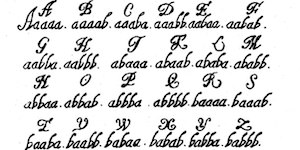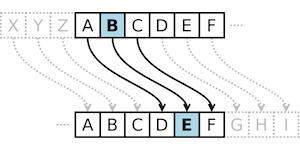Bacon cipher

The Bacon Cipher, also known as the Bifid Cipher, is a captivating method of encryption that involves the substitution of alphabet letters with binary symbols, 'A' and 'B'.
Unraveling the Bacon Cipher
The Bacon Cipher is a binary cipher that assigns binary values, 'A' and 'B', to each letter in the alphabet. The binary coding rules dictate the conversion. For instance, 'A' may represent one binary value (e.g., '00000'), and 'B' might represent another (e.g., '00001'). This conversion forms the basis of the cipher.
Historical Significance
The Bacon Cipher dates back to the 16th century and was named after its creator, Sir Francis Bacon. Bacon, an English philosopher, scientist, and statesman, is known for his contributions to many fields, including cryptography. This cipher has historical relevance, and variations of it were used for various purposes, including the concealment of messages during sensitive communications.
Applications
- Historical Cipher: The Bacon Cipher has historical significance and serves as an example of early encryption methods.
- Educational Tool: It is often used as an educational tool to introduce the concept of binary encoding and basic ciphers.
- Recreational Puzzles: The Bacon Cipher is a popular choice for puzzle books and games, offering a mix of history and mental challenge.
Algorithm of the Bacon Cipher
The algorithm of the Bacon Cipher is relatively straightforward. For each letter in the plaintext:
- Convert the letter into its corresponding binary representation using a predefined key. Typically, 'A' and 'B' are used.
- Combine the binary values for each letter, resulting in a binary string.
- Divide the binary string into two equal halves.
- Use the coordinates from these halves to determine the letter for the ciphertext.
Example:
- Original text: "BACON"
- Conversion (assuming 'A' corresponds to '00000' and 'B' corresponds to '00001'):
- 'B' (00001) becomes 'B' (00001)
- 'A' (00000) becomes 'A' (00000)
- 'C' (00001) becomes 'B' (00001)
- 'O' (?????) becomes '?????' (?????)
- 'N' (?????) becomes '?????' (?????)
- Encrypted text: "BAB?????," where '?????' represents the binary representation of 'O' and 'N'.
Conclusion
The Bacon Cipher, with its rich historical background, remains a captivating example of early encryption techniques. Although it is no longer used for secure communication due to its simplicity, it continues to be an interesting educational tool and a source of fascination for those interested in the history of cryptography. It exemplifies the creative ways in which information can be encoded and hidden.
Comments on the service

Caesar shift is a type of cipher in which each character is replaced by a character shifted by a certain number in the alphabet.
Go to calculation
A simple substitution cipher for alphabetical writing in which the n-th letter of the alphabet is replaced by the letter m - n + 1.
Go to calculation
A1Z26 is a simple method of encrypting text in which each letter of the alphabet is assigned a specific number, determined by its number.
Go to calculation